Cuban Missile Crisis
Saturday October 27th 1962 dawned clear, bright and frosty across Lincolnshire. Anyone passing by one of a handful of airfields in the county on that day could not fail to notice clusters of 3 65-foot tall blunt-tipped white columns each adorned with a single RAF roundel, all pointing vertically into the clear late autumn day. They may have looked at them, shuddered momentarily, and carried on about their business.
The 'columns' were Douglas PGM-17 Thor Intermediate Range Ballistic Missiles (IRBMs), the RAF stations were Bardney, Caistor, Coleby Grange, Folkingham, Hemswell and Ludford Magna.
At Waddington, Scampton and Coningsby, a passer-by would have noticed that the airfields were hives of activity, with more Vulcans sat on the readiness positions by the runway, and more armed guards visible than normal. More heavy vehicles than usual had been heard rumbling through the lanes around RAF Faldingworth at night during the past week, and locals knew that this meant something serious was afoot. The old airfield at Faldingworth had disappeared from OS maps of the area a while before. This gave the impression that it had been returned to agricultural use, though the truth was quite the opposite. RAF Faldingworth was one of the most secure and highly-guarded bases in the UK at the time, as it was store for a large percentage of the RAF’s nuclear weapons.
Protecting cover
Guarding the skies against hostile aircraft, the Gloster Javelins of No.64 Sqn at RAF Binbrook were at a higher state of readiness than normal, with aircraft loaded with live weapons. The coming of Javelins and Canberras to Binbrook necessitated longer runways to cope with the demands of the jet age. This had a knock-on effect on the local roads, so a new road was built to bypass the ends of the runways to allow traffic to safely flow whilst the airfield was active. This road was opened on October 19th 1962.
Looking along the ridge of the Wolds towards RAF Binbrook from almost anywhere in central and north Lincolnshire, the newly-erected dishes of the NATO ‘Ace High’ station at Stenigot were easily visible as 4 large white structures standing tall against the clear blue skies of that morning.
At North Coates near Grimsby, Woodhall Spa near Coningsby, Woolfox Lodge in the south of the county and Dunholme Lodge near Scampton, Bloodhound missiles stood ready on their launchers, 32 to a site, ready to fill the gaps in Britain’s air defences should Soviet bombers appear on the horizon.
As well as the overt military re-armament with modern weapons, the Government had been increasing the size of the Civil Defence Corps as a precautionary measure in the event that the UK suffered a nuclear attack. On October 20th, the Lincolnshire Echo reported that the Lincolnshire CDC had just exceeded 8000 members. In 1957, as part of the UK’s modernisation of its civil defence infrastructure , the CDC and the Royal Observer Corps became arms of the UK Warning & Monitoring Organisation (UKWMO). The Midlands regional HQ of UKWMO was in a newly-built semi-sunken bunker on the edge of the former RAF Fiskerton, just outside Lincoln.
Around the county, members of the Royal Observer Corps, now part of UKWMO were reporting for duty at their underground bunkers. Each had been through a rigorous training programme to teach them how to locate and classify nuclear weapons detonations. Each was well aware that in the coming days there was an increased likelihood that they would have to use this training for real instead of for the regular exercises they took part in.
Perhaps some of those noticing this extra activity, and the sudden absence of most members of the RAF from their neighbourhoods would have pondered what it was all about. Why the huge build-up on the quiet in the past week? After all, a member of the Cultural department of the Soviet Embassy in London had only that week been reported in the Echo as telling a public meeting in Sleaford to mark United Nations Day that Russia did not want war with the US, and supported full disarmament. Surely he was telling the truth?
Close call
The day was the last full day of British Summer Time for that year but was also known as ‘Black Saturday’ and was the closest point that the world has ever come to all-out nuclear war.
How did this come about? How did the rural county of Lincolnshire find itself at the very cutting edge of the RAF’s nuclear strike capability? What events led to these missiles being sat on their pads, less than 10 minutes away from being launched, and the V-force having a large number of aircraft armed with nuclear weapons, with crews at readiness in the cockpits on that cold Saturday 50 years ago?
We must first go back to the dying days of World War 2, and the dividing-up of European influence between the four victorious powers. The USSR took control of most of Eastern Europe and a sizeable chunk of Germany, including the area surrounding the capital, Berlin. This was to provide a security buffer for the USSR which had suffered enormous loss of life during the German invasion and subsequent occupation of parts of the country. Berlin itself was treated as a separate territory by the allies, and was divided into 4 sectors, one for each of the occupying powers. Road, rail, air & water access to Berlin were never formally guaranteed by agreement but relied on Soviet goodwill. This was to cause problems in coming years as relations between the USSR and the other three occupying powers deteriorated.
The border between the Soviet zone of occupation and the zones occupied by the US, France and the UK became known as the Inner German Border (IGB) and over time became probably the most heavily fortified and defended border in the world. This border and the later Berlin Wall became physical manifestations of Churchill’s “iron curtain”.
The USSR saw the future of Germany as being a unified communist state, and this goal was stated repeatedly during the latter part of 1945 and through 1946.
Winston Churchill remarked on the spread of Soviet influence and deteriorating relations between east and west in a speech at Westminster College in Fulton, Missouri in march 1946. This speech brought the phrase “iron curtain” into public use to describe the division in Europe:
“From Stettin in the Baltic to Trieste in the Adriatic an ‘iron curtain’ has descended across the continent. Behind that line lie all the capitals of the ancient states of Central and Eastern Europe. Warsaw, Berlin, Prague, Vienna, Budapest, Belgrade, Bucharest and Sofia; all these famous cities and the populations around them lie in what I must call the Soviet sphere, and all are subject, in one form or another, not only to Soviet influence but to a very high and in some cases increasing measure of control from Moscow.”
In 1946, elections were held in Berlin, and in response to shortages of necessities and harsh treatment of residents, the results returned a huge anti-communist majority, especially in the Soviet sector of the city. By this time, the US had recognised the need for a large assistance programme to get Europe back up and working productively. The USSR was not interested in this idea, desiring the defeated nations to remain subdued. In June 1947, the US Secretary of State George Marshall announced his European Recovery Programme of assistance, which became popularly known as the Marshall plan.
Stalin opposed this and began to formalise the eastern European states under his influence into a buffer zone, fearing that the US was trying to buy influence in Europe to turn the continent against the USSR. In early 1948, the UK, France and the US agreed to combine the economies of their zones of occupation in Germany to give the country a chance to recover, and to reduce the burden of cost it imposed. The prospect of German reunification horrified Stalin, and he immediately ordered a clampdown on access to Berlin, making access very difficult in the hope of forcing the other three occupying powers to relinquish their sectors of the city.
In May 1948 the UK, US & France introduced a new currency, the Deutschmark, in their zones of occupation. This was to replace the Reichsmark, which had been grossly devalued. This currency was introduced to Berlin too and rapidly became the preferred trading currency. Prior to this, the USSR had issued a new currency to be used in Berlin and declared that no other currency would be allowed. As a result of the introduction of the Deutschmark, the USSR cut off all surface traffic between Berlin and the western part of Germany. This left the city reliant on supply by air, and from mid-1948 until Easter 1949 the Berlin Airlift kept the city supplied.
In May 1949 the US, French and UK zones of occupation of Germany were integrated and named the Bundesrepublik Deutschland (Federal republic of Germany, West Germany, BRD or FRG for short). In response, the USSR turned over control of the Soviet zone of occupation to the ruling communist (SED) and renamed the zone to the Deutsche Demokratische Republik (German Democratic Republic, East Germany, DDR or GDR for short). Thus Germany became two separate states, divided by idealogy.
Further afield, similar tensions were seen in Korea. As part of the post-war division of territory Korea was divided in two along the 38th parallel, with Soviet forces occupying the northern part and US forces the southern part. The physical divide soon became a political one, with a communist government being set up in the north and a US-supported capitalist one in the south – an uncanny reflection of what was happening in Germany at the time.
Unlike Germany, friction over the lack of free elections across both sides of the Korean Peninsular in 1948 led to skirmishes and air attacks across the dividing line, culminating in an invasion of the south by troops from the north in 1950. Military intervention was approved by the UN with troops from 20 nations being sent to the peninsular in support of the south. The UN-mandated international forces rapidly pushed the north Korean forces back to the Yalu river, near the Chinese border by mid-October. At that point, the Chinese committed vast numbers of troops and the Soviets began supplying modern weapons to both the Chinese and north Koreans. By the beginning on November, 1950, Stalin allowed Soviet air force aircraft and pilots to fly in support on North Korean and Chinese forces. This turned the tide in favour of the communist-backed forces, and by January 1951 they had pushed the UN forces back to the 38th parallel. The frontline of fighting remained around this area until mid-1951, when the war settled down into a stalemate based around fixed positions just north of the 38th parallel. This continued until armistice negotiations began in July 1953. The negotiations lasted until November 1954 and eventually resulted in the two halves of the country becoming separate nations, divided by the 38th parallel with a demilitarised zone either side of the border itself.
Back in Europe, the blockade of Berlin prompted the creation of a formal alliance between five European countries (UK, France, Belgium, the Netherlands and Luxembourg – all signatories of the 1948 treaty of Brussels) in the Western European Union Defence Organisation (WEUDO). This organisation’s charter called for the member states to respond militarily to an attack on any of its members.
Given the sheer size of Soviet forces in Europe at that time, it was quickly realised that the US needed to be brought in to make the deterrent credible. The US and a further 6 western countries signed up with the 5 WEUDO countries to the North Atlantic Treaty in April 1949. The members agreed that an attack against any one of them would be considered an attack against all of them and to use any means necessary of restoring and maintaining the security of the North Atlantic area. The alliance became known as the North Atlantic Treaty Organisation, NATO for short. A further two countries, Greece and Turkey, joined NATO in 1952.
That same year, Stalin advised the East Germans to build up and defend the Inner German Border. This they did, and cut off all access from West to East Germany along its length. This now left only Berlin where it was still possible to cross from east to west, and the city became the focus for defections to the west by disaffected East Germans.
On March 5th 1953 Stalin died and was replaced by Georgy Malenkov. Malenkov attempted some degree of reform in the USSR, but this was mainly unfruitful and caused serious problems within the Soviet Union, in much the same way that the dissolution of the USSR would do in the 1990s. Internal political problems took their toll too, and by 1955 he had been usurped by Nikita Khrushchev.
In 1954 the USSR, under Malenkov’s leadership, suggested that it too should become a member of NATO, but this was rejected by the member states.
Khrushchev was a reformer too, albeit along different lines to Malenkov. He shocked the world with his “secret speech” which denounced Stalin and revealed many of Stalin’s crimes against humanity. He firmly believed that the USSR could be defended by missiles alone. He reduced the headcount of the Soviet forces and invested heavily in modern technology and research. Khrushchev presented a more human face to the world than his predecessors had, and believed that he could reach an understanding with the west. Unfortunately he did not impress the western leaders, and his failure to make inroads with them fuelled his distrust of them and began to influence his approach to international affairs. He repeatedly overplayed the USSR’s hand regarding numbers and capabilities of nuclear missiles, and throughout the early years of his tenure in power, his threats to annihilate the West with his nuclear weapons became a familiar and oft-repeated refrain.
May 5th 1955 saw West Germany finally declared as a sovereign state. Unsurprisingly, the USSR countered this by declaring East Germany a sovereign state that year too.
West Germany was admitted as a full member state into NATO following the declaration of sovereignty. The USSR, in response to this, formed the Warsaw Pact just five days later. This was a mutual defence treaty signed by the USSR and the 8 communist states in eastern Europe. The principle strategy of this pact was to prevent an invasion of the USSR. Whilst the treaty was ostensibly a collective security arrangement, in reality the USSR dominated militarily.
A year later, in 1956, NATO internal relations were strained by the abortive attack on Egypt after Gamal Nasser decided to seize control of the Suez canal, a vital artery between Europe and the Middle and Far East for commercial and military shipping alike. When Britain, France and Israel launched their offensive to wrest back control of the canal, the United States applied fiscal pressure on the United Kingdom in order to force a halt to the operation, which its political masters did not agree with. Britain was forced to withdraw, or face the prospect of national bankruptcy as the United States had threatened to withdraw vital financial backing from the UK, which was still seriously struggling in the aftermath of the second world war. This humiliation severely soured relations between the UK and the US and threatened to undermine the entire relationship between the two countries.
In spite of the financial hardships that faced Britain, the Government understood the need for a strong, modern air arm. Beginning almost immediately after the end of the second world war, specifications were circulated to aircraft manufacturers for the aircraft that would see the RAF through the next 30 – 40 years. These specifications led to the production of the Valiant, Victor and Vulcan – Britain’s three “V-bombers” which formed the V-Force. Other key aircraft from this time included the Canberra medium bomber and the Lightning, Britain’s first mach-2 capable interceptor. The supersonic TSR-2 bomber / strike aircraft was also conceived at this time, but ultimately never entered service.
Britain, at this time, was still effectively isolated from US advances in weapons technology by the US Atomic energy Act of 1946 (commonly known as the ‘McMahon Act’) which had overturned the Quebec agreement of 1943 and the Hyde park agreement of 1944 where provisions for post-war atomic technology sharing had been set out and agreed. Despite having been a full partner with the US in the Manhattan Project which delivered the world’s first atomic weapons during world war 2, the UK was not able to access any data or technology related to nuclear power or weapons during this time. The isolation would last until the 1946 act was finally amended in 1954.
This led the Ministry of Defence to sanction the development of both atomic and thermonuclear weapons to be used by the RAF. These were successfully tried and proven in multiple series of tests in both Australia and on islands in the Pacific.
These developments led to the deployment of the first British thermonuclear bomb to the squadrons of Bomber Command’s V-Force in 1959. Codenamed Yellow Sun, it was a large air-dropped ballistic bomb, measuring 21 feet long and weighing in at over 3 tons. Two years later, in 1961 the yellow Sun Mk2 was deployed, weighing in at a much lighter 0.8 tons due to abandoning the British warhead design and adopting a British-built modified version of the US-designed W28 warhead. Yellow Sun Mk2 stayed in service until 1966 when it was replaced with the WE177 free-fall nuclear bomb. The WE177 had a remarkably long service career, finally being retired by the RAF in 1998.
With the introduction of Yellow Sun Mk2, the RAF began to change its method of operation. From early 1962, one bomber from each of the V-force squadrons was held at 15 minutes’ readiness armed with a live nuclear weapon. This was known as Quick Reaction Alert, or QRA – one of the defining acronyms of the cold war. The crews assigned to QRA lived, ate and slept in accommodation on the dispersals next to their aircraft for the period they were assigned to this duty – usually a 24-hour stint every couple of weeks.
Once viable air-dropped nuclear weapons were in production, interest turned to delivering them by missile rather than manned bomber. This lead to the Blue Streak missile being developed by the de Havilland Company in Hatfield to meet an Air Ministry requirement issued in June 1953 for a ballistic missile capable of carrying a nuclear warhead of megaton size over a range of 2-2500 miles. Work proceeded at a rapid pace through the 1950s, with sites being set up at Westcott in Worcestershire, Spadeadam in Cumbria and Woomera, in the Gibson Desert in Australia. It was recognised that a missile housed and launched from above ground would be vulnerable to enemy attack, so plans were drawn up for launch silos to be constructed. Sites in East Anglia and Salisbury Plain were identified as suitable, but a test bore of a hole at Duxford showed that the water table was too high at that site. This left Upavon on Salisbury Plain as the location chosen for the test build of a silo in the UK. In Australia, site 6CD at the Woomera test range was allocated for a silo, and work progressed as far as a huge hole being dug in a rock formation to house the silo, which was never completed. The project was going so well that the Ministry of Defence issued a statement in June 1957 to the effect that no replacement for the manned V-bombers was being developed as the role of nuclear strike would be undertaken by ICBMs by the time replacement was needed. However, by 1959, things were not so rosy. The Government of the day ordered a review of the project, and its findings were published on December 23rd 1959. The review panel stated that silo- or fixed-based missiles were only of value as a first-strike weapon, and held no retaliatory value. Only a mobile-, air- or sea-launched nuclear weapon system would be effective in all circumstances, and the only way to obtain this by the required date of the mid-1960s would be to buy the weapons from the USA. If this was not possible, then the UK should either accept the limitations of the Blue Streak system, and carry on with development & deployment, or cancel the program altogether and accept a gap in the country’s nuclear capabilities until such time as an alternative could be procured. The Treasury was in favour of cancellation, the USA offered the Douglas Skybolt as an air-launched weapon for use with the V-bombers, and so on April 13th 1960, Blue Streak was cancelled.
Skybolt would not have been the first air-launched stand-off nuclear weapon that the RAF operated, however. In September 1954 the Ministry of Supply placed an operational requirement for an air-launched stand-off missile for use with the V-bombers. It was to carry a nuclear warhead over a range of 100 nautical miles, at heights of over 70,000 feet to protect it from Soviet surface-to-air missiles, and travel at speeds up to mach 2.3. Avro were awarded the contract, and the weapon became known as Blue Steel.
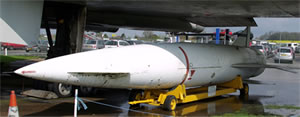
Blue Steel round at Newark Air Museum
It was powered by an Armstrong-Siddeley Stentor rocket motor, fuelled by 400 gallons of hydrogen peroxide and 80 gallons of kerosene. It was expected in service by 1960. By early 1958, Avro were admitting that the project had slipped and was unlikely to meet this in-service date. Later in 1958, the Ministry of Supply noted that Soviet defences were rapidly improving and issued a further amendment to the requirement, this time increasing the required range to 1000 nautical miles. Avro began work on the Blue Steel Mk2 even as work on the Mk1 was progressing. Blue Steel Mk2 had an in-service target date of early 1963 and was expected to remain in service until the Douglas Skybolt missile, a joint UK-US development, entered service in 1966. Avro were forecasting Blue Steel mk1 to be in service by early 1962 at this point. Delays dogged the project, Avro were hampered by problems with Blue Steel Mk1 caused by diversion of resources from Mk1 to Mk2. A lack of resources at the Royal Radar Establishment at Farnborough that would cause conflicts between the Blue Steel Mk2 & TSR2 programs was identified, and in late 1959 a decision was taken to cancel the Blue Steel Mk2 in early January 1960 in favour of the Skybolt. For a variety of reasons, the US unilaterally cancelled the Skybolt program in December 1962.
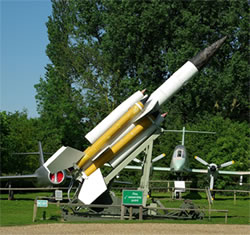
Bloodhound Mk1 missile on launcher on display at
NASM, Flixton, Suffolk
Britain was developing missiles not only for attacking ground targets. Vickers, Bristol and other companies were developing air-to-air missiles to arm the new generation of fighter and interceptor jets, as well as radar-guided surface-to-air missiles to act as layers in the defence of the RAF’s airfields. Bristol developed their Bloodhound SAM for RAF service to destroy enemy bombers up to 100 miles from Britain’s shores. The Bloodhound was powered by two Bristol Thor ramjet engines, and was boosted away from its fixed launcher by four Gosling solid rocket motors. Such was the thrust from these that the missile was travelling at 400mph by the time it had left the launcher’s rail, and was supersonic by the time it had travelled a further 25 feet. Three seconds after launch, the 4 booster rockets were jettisoned and at that point the missile was travelling at Mach 2.5.
The V-force airfields of Lincolnshire were served by Bloodhound sites at North Coates, Dunholme Lodge, Woodhall Spa and Woolfox Lodge. In addition to being an operational site, Dunholme Lodge was also designated as a trials satellite station to support the North Coates site and the Bloodhound force as a whole.
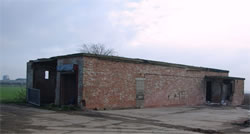
Remains of a Bloodhound launch control post at
former RAF Dunholme Lodge.
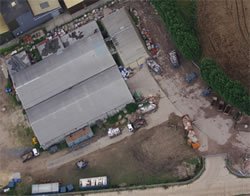
The Bloodhound missile servicing building at former
RAF Dunholme Lodge.
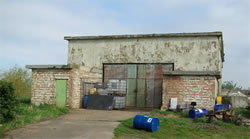
The Bloodhound missile arming shed at former
RAF Dunholme Lodge.
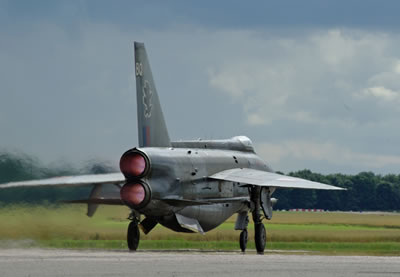
EE Lightning operated by the Lighting Preservation Group at Bruntingthorpe
Additional emphasis was given to development of surface-to-air missiles by Duncan Sandys’ announcement in 1957 that the manned fighter was obsolete, and there would be no further development of the type – missiles were the future. History proved him wrong, and fortunately for the RAF, English Electric continued development of their P1 aircraft, which was developed into the Lightning and became a familiar sight in the skies of the county around Coningsby and Binbrook. The Lightning became one of the mainstays of the RAF’s all-weather fighter force throughout the remainder of the cold war until its eventual retirement in the late 1980s.
Around the mid-1950s, the USSR had begun to catch up, and then overtake, the US lead in space and missile technology. Communism was being actively promoted and the governments of the western world became increasingly concerned about the spread of communism and were actively involved in countering it wherever possible. As if to underline the aggressive push of Communism, November 1956 saw Soviet forces invade Hungary and the popular uprising which followed this invasion was brutally put down by Soviet troops. As a means of early strike, the USAF Strategic Air Command regularly deployed squadrons of nuclear-capable bombers across the Atlantic to airbases in Europe, and the US Army deployed tactical nuclear weapons in various European countries, notably Germany, Italy and Turkey. It was the latter country, where 15 Jupiter missiles were based, that sparked the fury of the head of the USSR, Khrushchev. Ironically the Jupiter deployment that angered him so much was undertaken as a direct result of his own constant threats of nuclear annihilation of the West.
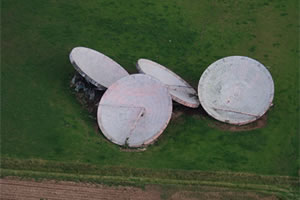
ACE HIGH dishes at NFSS Stenigot after scrapping.
As NATO grew stronger, the member states began to upgrade the communications links between them. In the early 1960s, a long-range tropospheric scatter communications system serving the Allied Command in Europe (ACE) was brought into service. ACE High as the system was called linked NATO bases from the Faeroes to the far east of Turkey in a wide arc round the edge of Europe. The system consisted of a total of 89 stations, 49 of them being tropospheric scatter stations which had sets of easily recognisable pairs of dish antennae set to point to the next stations in the chain and offered 200 communications channels, each capable of simultaneously hosting 12 voice calls. The bandwidth was divided up between voice, telegraph and data links.
Stenigot, high on the wolds of central Lincolnshire was one of 5 ACE HIGH tropospheric sites in the UK, connecting to Brizlee Wood in Northumberland and Coldblow Lane, near Detling in Kent. The 4 60-foot high aluminium dishes were raised up off the ground on long steel lattice support legs and were clearly visible from most parts of the county. ACE HIGH’s main purpose was to provide a dedicated, secure communications network between the heads of the armed forces of NATO members in Europe for use in times of crisis when other methods could not be relied on.
A further defence-related communications network, named Backbone, had 3 sites in the county with tall, rocket-shaped lattice masts at Claxby, Kirkby Underwood and Carlton Scroop.
Years of secrecy and paranoia under the rule of Stalin had created an inward-looking and deeply mistrustful mindset in the Soviet political elite, and this permeated down through the strata of Soviet society. The paranoia was so extreme that the Soviet leadership were utterly convinced that the US was out to destroy them. Inside the US, the military was constantly playing on the sensitivity of their politicians over the leads, both real and perceived, that the USSR had over them in missiles, space technology and other areas. To try to gain an insight into the real picture of Soviet missile and military capabilities, the US undertook a series of overflights of the USSR, resulting in several aircraft being shot down, the most famous of which was Lt Francis Gary Powers in a Lockheed U-2 operated by the CIA on May 1st, 1960. This incident, on the back of assurances from US President John F. Kennedy, caused an instant chilling of already strained relations between the USSR & the USA.
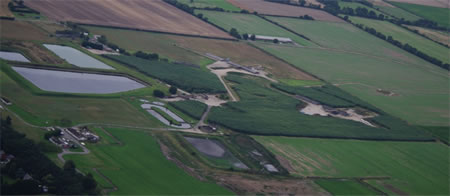
The layout of a typical Thor site, former RAF Caistor
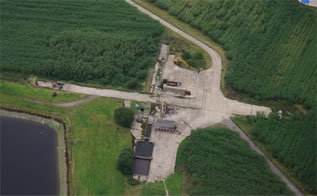
The remains of a Thor launch emplacement, former RAF Caistor
The USAF had a large, modern bomber force, but long-range missiles were in their infancy in the early 1960s. The Atlas and Minuteman intercontinental ballistic missiles were not deployed in any great numbers until 1963, leaving the USAF reliant on shorter-range missiles to supplement the bomber fleets. The Thor IRBM was a relatively short-range strategic missile, with an effective reach of roughly 1500 miles. This was too short to allow the missiles to be based in the continental US and targeted at major Warsaw pact targets, which are mainly in the western part of the USSR and Eastern Europe. Thus, an offer was made by US President Eisenhower to Prime Minister Harold Macmillan at the 1956 Bermuda conference for the short-term basing of 60 Thor missiles and associated support equipment in the UK. This offer was accepted, and plans were drawn up initially for all of the missiles on a single site, then changed to 3 sites with 20 missiles apiece, and by early 1958 had evolved to 4 Wings of missiles, each comprising 5 squadrons of 3 missiles distributed across a Wing HQ site plus 4 satellite sites. The missiles were originally to have been operated by US personnel, but Strategic Air Command finally conceded that this would be politically unacceptable and the deployment plans were altered to allow for the missiles to be manned by RAF personnel with a US presence at each site.
The Ministry of Defence arrived at this basic plan, which was close in detail to the final deployment, without having sites surveyed. At a meeting between the RAF & USAF in January 1958, the siting guidelines were drawn up: The bases in each group were to be a maximum of 30 miles apart from each other, a minimum straight-line distance of 12 miles from the Wing HQ base and ideally around 15 road miles from it. The reasoning behind the 12 mile minimum distance was to allow for survivability in the event of a Soviet strike – one warhead could not take out more than one site. This had the effect of ensuring that at least 20 Soviet missiles would be tied up solely to take out the Thor sites, possibly giving other targets such as population centres a reprieve. Surveying began early in February 1958 with an inspection of RAF Feltwell in Norfolk, and continued later that month in atrocious weather when a 15-man survey team visited the other 6 proposed Wing HQ sites. Of the 6 additional sites surveyed, only 3 met the necessary criteria which included not conflicting with any of the main V-bomber bases or V-force dispersal bases and that the sites must be protected by the coverage of the Bloodhound Mk1 surface-to-air missiles operated by Fighter Command. The surveys of the satellite sites for the Hemswell wing were done on 10th/11th April 1958, with only Caistor & Coleby Grange being identified as excellent sites for the missiles – Digby was classed as totally unsuitable, Kelstern would require a major program of demolition and road-building before work could begin on Thor facilities. Ludford Magna was at that stage an explosives storage site, holding around 10,000 tons of bombs, and lacked suitable drainage (it was known as ‘Mudford Magna’ by aircrew stationed there during the Second World War for good reason as period photographs show!). Bardney was also assessed as having insufficient drainage. Folkingham, part of the North Luffenham Wing, was surveyed on May 24th 1958, and on the same day North Witham and Harlaxton were surveyed and deemed unsuitable.
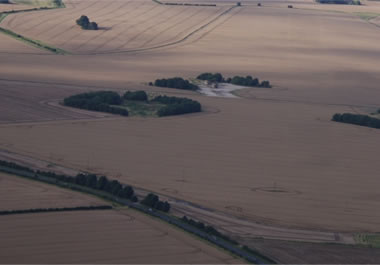
Remains of the Thor launch emplacements at Ludford Magna
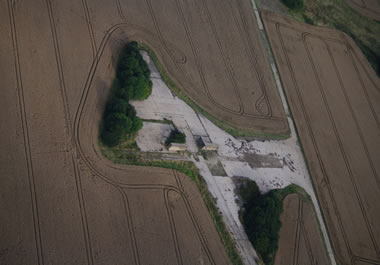
Remains of the Thor launch emplacements at Ludford Magna
Two of the sites in Lincolnshire had existing non-military users – a flying club at Bardney and the BRM motor racing team used Folkingham for testing their cars as it was the nearest available site to their headquarters at Bourne. Both BRM and the flying club were allowed 6 months’ notice to vacate the sites.
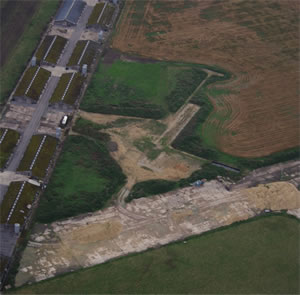
All that remains of a Thor launch emplacement
at former RAF Bardney
The project was officially given the code-name Emily on 27th May 1958, apparently in honour of the pin-up for that month on a calendar on an office wall. In that same month that the first contracts were drawn up for building work related to the project. In terms of cost breakdown, it was agreed that the US would pay for all of the missiles plus associated hardware, equipment and the training of the launch and maintenance personnel. The UK would pay for the bases and the service personnel, plus any civilian support required. The sites were constructed by a UK company, Sir A. McAlpine & Son Ltd, but were fitted out by Douglas contractors who also verified all of the systems once the site was complete, prior to handover to the RAF. In all, over 11000 tons of equipment from the missiles and launch control vehicles down to the grills used for drainage in the launch emplacements was flown over from the US to several designated air-heads in the UK on C-133 Globemaster aircraft, the flights becoming known as the 'Thor hauls'. The flights for the North Luffenham and Hemswell Wings used those airfields as air-heads for the inbound cargo for the sites in their Wings. From the air-heads, equipment was transported by road to the satellite sites. The several hundred Douglas contractors required for the site fit-out work for the Hemswell Wing were housed in caravans at Sturgate & Kirton-in-Lindsey. In January 1959, the senior Douglas representative for the project was replaced after the workforce had been holding up work due to their unhappiness with 60-hour weeks, homesickness, inequality of conditions with US servicemen stationed in the UK (principally a lack of duty-free allowance of cigarettes and spirits that the servicemen were entitled to) and a lack of discipline. This slowdown did not greatly affect the project, however.
The 20 required squadrons were formed, with RAF personnel being sent to Vandenberg AFB, California for training in the new systems. Each missile crew course finished with a live firing of a test missile on the Pacific Missile range from Vandenberg AFB and then returned to the UK to begin active duty on their squadrons. Unusually, the squadron structure followed the US model and was based on capability rather than rank. This meant that an inexperienced Flight-Sergeant might find himself under the command of a highly-skilled and experienced Corporal. By all accounts, this caused much less friction than had been anticipated.
The first Thor squadron to be activated was 77(SM)sqn at RAF Feltwell in Norfolk on September 1st 1958. The (SM) designation on the squadron number denoted Strategic Missile to differentiate the units and their ‘airframes’ from conventional flying units in the RAF. The Hemswell wing formed with the establishment of 97(SM)sqn at Hemswell on December 1st 1958, with the remaining 4 squadrons standing up on July 22nd 1959. These four units were 269(SM)sqn at Caistor, 104(SM)sqn at Ludford Magna, 142(SM)sqn at Coleby Grange and 106(SM)sqn at Bardney. The Hemswell wing squadrons used RAF Scampton as their airhead after the site construction work was complete.
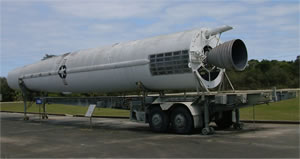
A Thor in USAF markings on its transporter/erector/launcher
(TEL) trailer, US SMM, Cape Canaveral AFB Florida
The North Luffenham wing was activated later than the Hemswell wing, with 223(SM)sqn standing up at Folkingham on December 1st 1959. This wing used RAF Cottesmore as its airhead.
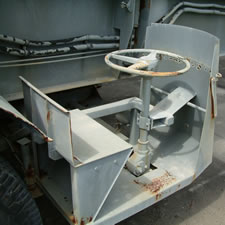
A close-up of one of the rear steering positions
on a Thor TEL, necessary for negotiating the
windy Lincolnshire roads with a 65 foot long
missile.
Unlike the V-Force crews, the Thor missile crews did not have visibility of what their targets were. Each missile had a prime and alternate target allocated, and these were communicated to each crew as a 15-digit number, delivered in a sealed envelope. The missile’s targeting would be checked at the start and end of each shift, and was frequently changed between the two allocated targets during a shift. The targeting alignment was set by adjusting a series of dials to feed the correct information into the missile’s inertial guidance system. This controlled the motor’s burn duration, and course corrections in flight so that when the motor cut out the missile was at the correct point in space at the correct speed and on the correct heading to deliver its warhead onto the target. The inertial guidance system was heavily reliant on the missile ‘knowing’ where it had started from. This need for accurate coordinates of the missile centre on the launch pad explains the need for careful and repeated surveying of the pad positions. The checking of the missiles’ guidance system was achieved by use of three electronic theodolites – two short-range ones on each pad, with a central long-range one sited between all three pads on a complex.
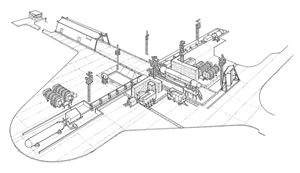
Drawing of a Thor pad in use. ©English Heritage
In early 1961, John F Kennedy was elected as President of the United States. His relationship with Khrushchev began badly when he issued an aggressive response to one of the Soviet leader’s addresses to the USSR on the subject of confrontations in the cold war. Kennedy misinterpreted this as a challenge from Khrushchev to him personally and rose to the bait, catching the Soviet by surprise. In a series of subsequent meetings with Khrushchev, Kennedy came off second best and became angry at the Soviet’s abrasive style and at himself for allowing the Soviet leader to bully him.
Shortly after he took office, Kennedy authorised the CIA-sponsored invasion of Cuba. Cuba sits 90 miles off the southern shores of Florida and since 1956 had been ruled by the communist firebrand Fidel Castro. Castro’s forced fully seized power in 1959 and began a programme of property seizure for the state, along with the introduction of forced labour, ‘re-education’ camps and execution for opponents. By 1961, Florida had received hundreds of thousands of Cubans who had fled the new regime. Castro received generous military support from the USSR, and parades from early 1961 featured increasing quantities of Soviet-made military hardware.
The invasion was to have been carried out by Cuban exiles, and then supported by the US military when Castro’s forces reacted. The objective was to seize back control of the island from Castro’s communists and to depose his Government. However, the plan went awry and the invaders received a hostile response from the locals. The promised US military support did not materialise and within three days the invasion was over. It was a humiliation for Kennedy and he suffered taunts from both Castro and Khrushchev over it, further denting his ego.
Whilst this was happening, the Khrushchev upped the ante by declaring that his previous demands over resolution of the issue of the occupation of Berlin had not been met. He announced that the USSR would sign a treaty with East Berlin which would remove any third-party rights of occupation in any of the sectors of the city. Kennedy assumed that the only realistic outcome of this would be nuclear war. Having used the perceived ‘missile gap’ between the USSR & US in his election campaign the previous year, Kennedy now made a speech in which he announced $3.25 billion additional funding for the defence budget and the increase of the US armed forces by 200,000 men as well as declaring that any attack on West Berlin would be seen as an attack on the US itself.
In little over a month between June and July 1961 over 20,000 people fled from East Berlin to the west, frightened by this sabre-rattling.
The East German government reacted to this with alarm, imposing ever-greater restrictions on the freedom of movement between the western nations’ sectors and the Soviet sector in Berlin. This was in response to mass emigration of educated and skilled East Germans to the west via the city. On August 12th, 1961, the East German president, Walter Ulbricht, ordered the start of construction of a physical barrier to seal off the western sectors of Berlin from the rest of East Germany. The move was authorised by Khrushchev himself. This divided the city, cut family members living in the western zones off from their relatives in the Soviet sector, and effectively restricted all movement between the halves of the city. No longer could East Germans use Berlin to come west to freedom.
Kennedy initially ignored this development as travel between the two halves of the city was still possible, but quickly changed his approach when he learned that Berliners believed he would not defend them against East German and Soviet aggression. He dispatched his Vice-President, Johnson along with a large military convoy from West Germany along the road route into West berlin through east Germany, passing through every East German and Soviet checkpoint on the way to prove that he was still prepared to support West Berlin. Relations between the USSR and the west deteriorated even further.
During January 1962 the Organisation of American States (OAS) suspended Cuba’s membership and imposed economic sanctions on Cuba. The next month, the US followed suit and imposed an economic embargo on the island. Early in 1962, in the course of a visit to Cuba by a Soviet agricultural delegation, a team of missile and construction specialists operating in the guise of delegation members obtained a meeting with Castro.
They suggested that the USSR might build missile bases on the island to help counter the Jupiter and Thor missiles stationed in Europe within reach of the USSR and also to act as a deterrent to another US-sponsored invasion attempt. Castro and the Cuban leadership were delighted at the prospect and planning began. Khrushchev had been aware of Kennedy’s fears of a missile gap between the US & USSR and played upon it, talking up the USSR’s missile stocks and production rates to disguise the fact that they were substantially below US levels for long-range missiles and could not directly threaten the continental United States. This was too good an opportunity to pass up as it placed the medium-range missiles within easy reach of the US and would also make Kennedy aware of how exposed Khrushchev felt about having the Thor and Jupiter deployments within striking distance of his homeland.
Soviet missile technicians and construction engineers were sent to Cuba using the cover of ‘agricultural specialists’ and ‘machine operators’. They arrived in July and began surveying sites. A number were identified as suitable and construction work began. The Soviets were so determined that the missile deployment would be carried out in secret and presented as a humiliating surprise for Kennedy that they did not tell the missile troops where they were going, and equipped them with skis and cold-weather clothing. On July 7th 1962 Khrushchev signed his approval for the deployment of Soviet surface-to-surface nuclear missiles to Cuba.
The US had their suspicions that all was not as it seemed in Cuba. In August US intelligence agencies received reliable sighting reports of Soviet-made MiG-21 fighters and Ilyushin Il-28 bombers at airfields on the island. Overflights by U-2s had revealed the presence of at least 8 batteries of Soviet-built surface-to-air missiles (SAMs) at different locations too. On August 10th, the director of the CIA John McCone wrote a memo to Kennedy stating that he believed the Soviets to be preparing to base ballistic missiles in Cuba. On August 31st, the US Senate was tipped off by a New York Senator that Cuba was probably constructing missile sites, information which probably came from numerous Cuban exiles in the Senator’s constituency.
By early September, work was well underway with site construction. That same month, the Cuban leadership was angered by the US Congress’ approval of a resolution to prevent Cuba raising a military establishment supported by any external country. Shortly afterwards, the US military announced a major exercise was to be held in the area, prompting alarm in the Cuban leadership that this was to be cover for an invasion attempt.
The first batch of Soviet R-12 missiles (NATO name SS-4 /Sandal) arrived on September 8th 1962, with the second consignment on the 16th. In all, there were to be 9 bases built. 6 were to house the 1200-mile range R-12 missiles and the remaining 3 were to accommodate the longer-range R-14 (NATO name SS-5 /Skean) missiles which had a reach of 2800 miles. Overall, 40 launchers were to be located across the 9 sites. The missiles would have had the range to reach almost all of the US.
After the first missiles had arrived, US intelligence officials received a handful of reports of what could only be missiles being transported at night with great difficulty through villages on the islands.
Such was the degree of concern in both Castro and Khrushchev that an invasion was imminent that on the 11th September Khrushchev announced that any US-led attack on Soviet shipping headed to Cuba would be taken as an act of war. The same day, the Soviet news agency TASS issued a statement that the USSR did not need or intend to introduce offensive nuclear missiles into Cuba. Four days earlier, the Soviet UN ambassador, Dobrynin gave an assurance to his US counterpart Adlai Stevenson that the USSR was only supplying defensive weapons to Castro’s forces. These lies would be repeated by the Soviets until the point that they were shown to be untrue.
Why were the missile sites not spotted earlier than they were? Because of a Soviet protest arising from a U2 overflight of Sakhalin island by the USAF, and an incident in which a Taiwanese U2 was shot down over China by SAMs, U2 surveillance had been suspended between September 5th and October 14th. The CIA feared that a shooting-down of one of its U2s by a Cuban or Soviet SAM would spark a major international incident in the wake of the two previous ones. At this time, the U2 surveillance of Cuba was still owned and run by the CIA. After some discussion and a realisation that Cuba needed watching closely, ownership was transferred to the USAF and U2 overflights of Cuba resumed on October 14th. Overflights had been authorised to restart on October 8th, but bad weather gave the Soviets a week’s further grace from discovery.
On the first flight since the resumption of U2 surveillance, Major Richard Heyser of the USAF shot 928 exposures over the island. In the frames taken over San Cristobal in western Cuba, he captured images of what was identified as an SS-4 site under construction. From descriptions of capabilities and requirements of the different types of Soviet missiles supplied in high-grade intelligence the types of missile involved were able to be determined accurately. This information had been passed to the US by Oleg Penkovsky, a spy opposed to Khrushchev’s nuclear threats who had been recruited initially by British intelligence in early 1961.
These images were studied closely by CIA photographic interpreters the following day and objects were seen on the site which were identified as medium range ballistic missiles. At 8.30pm that evening the President’s National Security Advisor was informed of the discovery. He waited until the following morning to brief Kennedy, taking with him the photographic evidence. Kennedy called a meeting of the nine members of the National Security Council plus five other advisers at 6.30pm on October 16th to discuss the findings and prepare a response, as this was not a situation the US had anticipated finding itself in. The meeting discussed several options, from a diplomatic response through blockade of the island and selective airstrikes against the missile sites to a full-blown invasion and occupation of Cuba.
The US Joint Chiefs of Staff (the heads of each branch of the military) were unanimous in their support of an immediate attack on, and invasion of Cuba. Kennedy was wary of this option as he believed that it would give the USSR carte-blanche to attack and seize west Berlin.
October 18th saw Kennedy meet with the Soviet Minister of Foreign Affairs, Andrei Gromyko (who would later go on to rule the USSR in the 1980s). Kennedy did not mention the discovery of the nuclear missiles but quizzed Gromyko on the other Soviet-supplied weaponry the Cubans had been given. Gromyko reiterated the official line that the weapons were purely defensive. Unbeknown to the US, the Soviet forces stationed on Cuba were also issued with small battlefield tactical weapons which they had been cleared to use against US forces without need to seek approval from Moscow in the event of a US invasion. Four Soviet submarines operating from Cuba were also equipped with nuclear-tipped torpedoes, and again these were authorised for use without need to refer to Moscow first.
The following day a U2 overflight revealed that there were now four operational missile bases on the island. The US military prepared two full operational plans for dealing with the situation. One was for invasion only, the second was for provision of a carrier group with sufficient flexibility to do anything from attack an individual site to support a full invasion.
By October 21st, Kennedy’s preference had settled on a naval blockade of the Cuba to prevent offensive weapons being landed there. This blockade was defined under the framework of the Organisation of American States and was supported by the member nations of that group.
The first that the British Prime Minister, Harold MacMillan officially knew about the escalating crisis in Cuba was on October 21st when the British Ambassador was personally briefed on the situation by Kennedy himself. There is speculation that a group of British intelligence officials visiting Washington may have been let into the secret the previous day.
As there were close links between the Commander-in-Chief of Bomber Command (CinCBC) and the Commander of the USAF Strategic Air Command, information would already have been flowing between the two regarding the crisis, as it would have had an impact on the dual-key crews for the Thors. CinCBC was able to covertly increase the number of bombers on QRA at the V-Force bases under the cover of an ongoing exercise that had received some prior publicity ahead of its start. He chose to increase the number of QRA-state aircraft from one per squadron to three, meaning that there were now roughly 15 V-bombers sat at 15 minute readiness all armed with live thermonuclear weapons.
At 3pm on October 22nd, Kennedy formally established the Executive Committee to run the crisis. By 5pm that day he was meeting with the leaders of the US Congress. They opposed the blockade and demanded a much tougher response. At roughly the same time, the US Ambassador to Moscow briefed Khrushchev on the blockade and the speech that Kennedy would deliver to the nation that evening. Across the world, similar briefings were given to friendly governments by their Ambassadors. The states of the Warsaw pact did not receive these briefings. Shortly before the speech was due, US delegations briefed the heads of Government of the UK, Canada, West Germany and France on the underlying situation and the intelligence evidence gathered.
Kennedy addressed the US nation on television at 7pm that night and revealed the presence of Soviet nuclear missiles on Cuba. He also announced the start of the blockade against the island, explained why it was being put into place and declared that the launch of any missile from Cuba against the US would be considered an act of war against the US by the USSR and would be met by a full military strike against the USSR. During the broadcast, US forces were raised from DEFCON5 to DEFCON3 alert status, two steps below a war footing.
On October 22nd, Oleg Penkovsky was arrested by the KGB and was interrogated to find out what information he had passed to the west. After the Cuban crisis had abated, he was tried for treason and executed in early 1963.
As the crisis in Cuba deepened, US forces’ families were evacuated from the base at Guantanamo on the island, beginning on October 22nd.
In the morning of October 23rd, as the world watched the crisis unfurl before them George Ball, a senior US diplomat, sent a cable to the US Ambassador in Turkey and to NATO advising them that the US was debating offering to withdraw the Jupiter missiles from Turkey. The US knew these missiles were close to retirement, and their deployment had provoked Khrushchev’s ire – perhaps this could be the key to defusing the crisis? Turkey considered this to be an affront to their nation and would not support it. The same suggestion appeared in a widely-published newspaper column a couple of days later. To try to cool the situation and step back from the brink, the US Department of Defense made a public statement that it had no plans to call up reservists because of the crisis in Cuba. Around the world, support polarised for the opposing countries – the western world was largely supportive of the US, whereas the communist bloc, plus Soviet puppet-states around the world and also China weighed in on the side of the Cubans.
The following day, as if to ratchet up the tension even further, Chinese troops invaded Indian territory, leading to another crisis as the Indian government called on the West for assistance and weapons.
Telegrams were exchanged between Khrushchev and Kennedy, with the Soviet conceding nothing and threatening that the US blockade would be taken as an act of international piracy and would mean war.
The US requested an emergency session of the UN Security Council on October 25th. At this meeting, the US Ambassador to the UN Adlai Stevenson confronted the Soviet Ambassador Valerian Zorin and challenged him to admit the existence of the nuclear missiles in Cuba. Zorin refused to answer Stevenson.
That day, Castro ordered an increase in the alert level of the SAM crews on Cuba. From October 26th onwards, they were to engage any US aircraft overflying the island, regardless of whether numbers. Previously his rules of engagement had prevented the defences opening up on individual aircraft, only pairs or more were legitimate targets. This escalation would lead to a tragic outcome.
Wednesday October 24th was United Nations day – the17th anniversary of the founding of the UN. It was designated as a day for celebrating friendship and ties between countries, for reaching out and making contact with other nations. To mark the day, the Chairman of the local branch of the United Nations Association, Alderman R.W. Chadburn of Sudbrook who had recently visited the Soviet Union, had arranged a meeting in Sleaford with the guest speaker being Mr Andrei Zobov of the Cultural Department of the Soviet Embassy in London. Mr Zobov addressed the 150 attendees and assured them that the weapons in Cuba were not fitted with nuclear warheads aimed at the US or anywhere else. He stated that Cuba, as a sovereign state, had the right to purchase weapons for the defence of its own territory, and because Cuba was near the US and had recently suffered a US-sponsored invasion attempt when the Cuban government told the Soviets that they felt they needed weapons to defend the country, the Soviets could not deny their request. He called the US blockade of shipping bound for Cuba ‘piracy on the high seas’.
On being asked about photographs of the missiles stationed on Cuba taken by US reconnaissance aircraft, he claimed that by overflying the island to take the pictures the US had violated the sovereignty of Cuba by allowing military aircraft to enter Cuban airspace without the permission of Cuba. He followed this up by saying that if the US Navy stopped Soviet ships bound for Cuba, it could possibly lead to nuclear war. Mr Zobov went on to state that the Soviet Union wanted peaceful coexistence with other countries of different social systems, and did not want war. He said that the Soviet Union still remembered the terrible losses of soldiers and civilians incurred in the Second World War and had no desire to repeat them. He called for complete disarmament by all nations and told the meeting that the Soviet Union had a plan for this in three stages over 4 years.
At 10pm on Friday October 26th, US forces were raised to DEFCON2. The Strategic Air Command fleet was dispersed to its wartime bases, with all bombers loaded with their full wartime loads. The aircraft were at 15 minutes’ readiness to launch on their war missions. This is the only recorded instance of these preparations being enacted throughout the entire cold war. In addition to the dispersal, approximately 150 fully-armed bombers were airborne on the SAC “Chrome Dome” airborne alert and a further 23 nuclear-armed B-52s were moved to holding orbits just outside Soviet airspace to give a clearly visible warning to the USSR that the US meant business.
In the UK, the Prime Minister made the Supreme Allied Commander in Europe aware that a full NATO mobilisation in Europe would be construed as an open, deliberate provocation to the USSR and would, as in World War 1, probably cause an escalation from crisis into conflict SACEUR agreed and did not order a full mobilisation. He did order that unobtrusive increases in alert and vigilance were to be made and that where it was possible without attracting public attention, more aircraft were to be prepared with their high-yield thermonuclear warloads rather than the low-yield ones they were loaded with normally for alert. MacMillan took the unusual decision to ensure that more of the V-force and the medium bomber force were fully bombed up with their nuclear warloads and crews were placed on heightened readiness levels. This increased the number of squadron aircraft on QRA from 3 to 6, although at least one squadron at Waddington was reported to have generated 9 Vulcans for QRA on that day. However, in order not to provide evidence of provocation to the USSR, he decided not to order the dispersal of aircraft to their wartime operating locations. Dispersal was a key element in the V-force war plan. It was conceived as a method of diluting any Soviet attack by presenting many targets to be covered rather than just a few and also to try to ensure the survival of as many bombers as possible to allow a successful strike against the USSR.
The RAF preparations for war were conveniently camouflaged under the guise of a pre-planned and announced exercise that was already running when the crisis began. The Chief of the Air Staff (CAS) and CinCBC decided to prolong the exercise by a few days, announcing this openly.
At the USAF bases in the UK, the tactical and strategic bombers were loaded with thermonuclear weapons, crews were moved to cockpit readiness and power sets were attached and kept running ready to start the jets’ engines and the protective covers were removed from the nuclear weapons. At the Holy Loch submarine base in western Scotland, three US submarines equipped with Polaris missiles unobtrusively left their berths and headed out to sea, accompanied by their supporting depot ship.
The Thors were already on a 15-minute readiness as this was their default state. This was a higher readiness level than the US officers assigned to the squadrons were at normally, and equated to their DEFCON2 state. When US forces were escalated to DEFCON2, the US dual-key officers withdrew personal weapons from the Thor site armouries and wore them at all times. In order to not draw attention to the escalating readiness state the warheads for the Thors were dispatched from Faldingworth to the Thor sites under cover of darkness. Instead of the normal easily-recognisable nuclear convoys used to transport the weapons, an eyewitness recalls that the weapons were instead loaded into the back of normal 3-ton trucks and were sent on their way accompanied only by a single RAF Policeman and his trusty guard dog. The warheads were stored away from the missile sites as none of the sites had a Secure Storage Area (SSA) co-located with them.
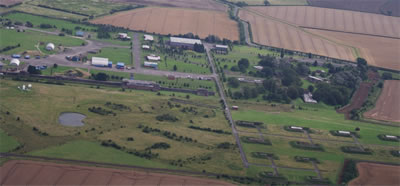
Aerial view of the former RAF Faldingworth showing some of the fissile material
storage buildings to the lower right. Above them, hidden by the trees, are the 3
atomic weapon storage buildings, and to the centre-left of the shot a type D1
mounded special weapons preparation store can be seen. The area with the lake
in also shows traces of having been used for fissile material stores and further D1
type stores.
As October 27th drew on, events took a turn for the worse in Cuba. A USAF U2 was ordered aloft to obtain an updated picture of the state of the missile sites and other preparations on the island. At midday EDT (5pm BST) Major Rudolf Anderson was shot down and killed by a Soviet SAM, fired in accordance with Castro’s diktat about engaging all US aircraft. The firing was ordered by Lieutenant-General Stepan Grechko, the commander of Soviet air defences in Cuba without consulting Moscow for approval. Later that afternoon several US Navy RF-8 Crusader reconnaissance jets were fired at by Cuban defences whilst on ultra-low-level photo sorties over the island, with one aircraft sustaining a hit from a 37mm anti-aircraft shell. All were able to return to their bases safely.
Tensions rocketed – earlier in the day a USAF U2 had accidentally entered Soviet airspace over Siberia. Soviet jets were scrambled to intercept it, but when it became clear that the Soviets were trying to shoot the U2 down, nuclear-armed fighters from Alaska were launched to intercept the Soviet jets. Fortunately the Soviets broke off before the US aircraft could engage them.
Khrushchev began to panic. For the past few days he had been sending out mixed messages to the US, some emollient and suggesting that the USSR did not want war, others deliberately brusque and provocative, deliberately upping the ante. Within the space of a few hours on October 27th, Kennedy was in receipt of both an open message from Khrushchev offering a deal over the withdrawal of the Jupiter missiles from Turkey and slightly later a vitriolic, aggressive private one withdrawing the earlier offer. Kennedy chose to respond privately to the first of the two communications and to discard the later, aggressive one.
By 1pm on October 27th, the cover of the increased Bomber Command readiness being due to the exercise was dropped. CAS declared an end to the exercise and CinCBC ordered an immediate increase in readiness to Alert 3 for the V-force and the Thors.
On October 27th, the Thors were taken from their ‘alert 15’ state to a ‘phase 2’ state, which involved removing the missile from its shelter, erecting it on the launcher and aligning the guidance system and holding it in lock. This left the missile requiring only fuel and LOX to be loaded and the final checks to be carried out before launch. From that state it was a maximum of 8 minutes to launch the missile. There is evidence that missiles within the Shepherd’s Grove and Hemswell wings were taken to an even higher state of readiness, with many witness accounts quoting that the missiles at sites in these wings were fully fuelled and loaded with LOX during the day on the 27th.
Mid-afternoon the following day, the alert was enhanced with CinCBC ordering more bombers to be loaded with thermonuclear weapons and the V-Force to be taken to QRA readiness across the board. This heightened state of alert was maintained from October 28th to November 5th.
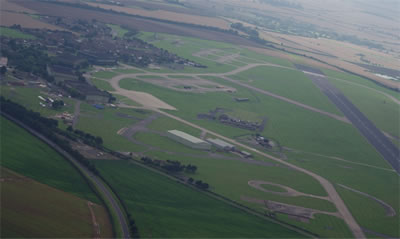
An aerial view of the operational readiness platform (ORP) at RAF Scampton where
the Vulcans on QRA duty would sit awaiting a scramble. The Supplementary
Storage Area where nuclear weapons were stored is visible at upper right in the shot.
At 2.30pm on October 27th MacMillan convened a hastily arranged meeting of the UK Joint Chiefs of staff of the armed forces. They were fully briefed on the escalations in Cuba and were advised that the US was planning an invasion on October 29th. The Joint Chiefs set out the steps that would need to be approved by an emergency cabinet meeting to put the UK on full war footing. It is believed that at this point MacMillan was within hours of calling the cabinet meeting that would have set the UK on the road to war and which would have set in motion for the first time the plans to disperse the Government to the network of secret bunkers and protected regional seats of Government (RSGs) across the country.
Whilst this was happening, across in the Caribbean the situation was coming to a head. The US blockade forces had been ordered to try to track the four Soviet submarines that were based in Cuba. The US warships were under orders not to directly attack the submarines but to try to force them to the surface to be identified. Messages stating this intended course of action were transmitted to Moscow to prevent this being taken as the beginning of conflict. The US authorities ordered the warships to drop practice depth-charges as soon as a Soviet submarine was located to signal it to surface.
The Soviet crews had been submerged for several weeks by this point and after the event it became known that several of the commanders had considered using the nuclear-tipped torpedoes as they considered themselves to be under attack. It would appear that Moscow had not forwarded the US messages regarding practice depth charges to the crews in the area. One captain ordered the preparation of the torpedo, but then stated that he had no intention of using it as they would all die when it detonated. On a second submarine, the captain was unable to establish communications with Moscow and became convinced that war had already started. He ordered his vessel’s nuclear torpedo to be prepared for firing. Fortunately an argument broke out between the three officers onboard who all had to approve the firing. One of the three was vehemently against launching the torpedo, and eventually persuaded the captain to surface in an attempt to contact Moscow and await orders. Commander Vasili Arkhipov deserves recognition as the one man who almost certainly saved the world from nuclear war.
Kennedy’s written reply to Khrushchev’s letter was sent late on October 27th and agreed to a permanent response to the Cuban issue along the lines that Khrushchev had set out, provided that the Soviets removed their missiles from Cuba. Kennedy suggested that the US would promptly end the blockade of Cuba and give assurances against the invasion of the island. What he did not state in writing, but which was communicated verbally to Dobrynin, the Soviet Ambassador, was that the Jupiters in Turkey would also be withdrawn at a later date in accordance with Khrushchev’s wishes.
At 9am EDT on Sunday October 28th, radio Moscow broadcast an open letter from Khrushchev to Kennedy stating that Khrushchev accepted and trusted Kennedy’s written undertakings and that work on the sites in Cuba had been halted, the missiles were being dismantled, crated and prepared for return to the USSR.
Kennedy drafted an immediate response calling the message an important and constructive contribution to peace. He wrote further that he took the correspondence between them as a binding undertaking and agreed to make a statement to the UN Security Council to the effect that the US respected Cuba’s borders and would not interfere in Cuba’s internal affairs.
Following this outbreak of peace, the US kept up the embargo on Cuba for short period. During those four weeks, all of the missiles were shipped back to the USSR. On November 20th 1962, agreement was reached with the USSR regarding the dismantling and return to the USSR of the Il-28 bombers that had been shipped to Cuba during the build-up to the crisis. When this agreement was reached, at 6.45pm EDT on that day the US lifted the blockade of Cuba.
The Jupiter missiles were withdrawn from Turkey by April 1963. Prior to the start of the crisis, the UK had agreed to scrap the Thors by late 1963 as they would be obsolete by that point and the US would be able to cover all of the USSR with its new generations of ICBMs. The last Thor left the UK to return to the US on September 27th 1963, ending the RAF’s brief tenure as a ballistic missile operator.
RAF stations in Lincolnshire that played a part in the RAF’s response to the Cuban missile crisis.
| RAF Bardney | RAF Binbrook | RAF Caistor |
| RAF Coleby Grange | RAF Coningsby | RAF Dunholme Lodge |
| RAF Folkingham | RAF Hemswell | RAF Ludford Magna |
| RAF North Coates | RAF Scampton | RAF / NFSS Stenigot |
| RAF Waddington | UKWMO Midlands HQ, Fiskerton |
